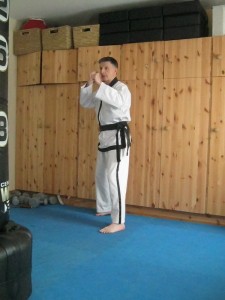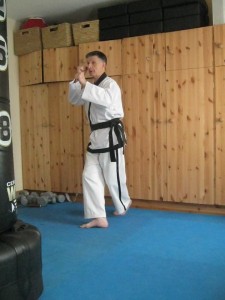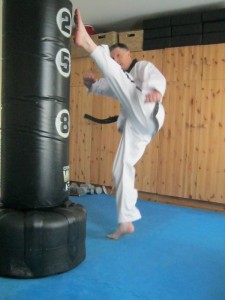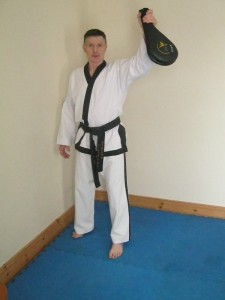Tailor Made Taekwondo Sparring Combinations Part 2 – Using the Axe Kick
Before we get into the axe kick, just recap on last month when we covered eight points that would benefit putting a combination together. Now we add two more.  The first is to have one for distinct Taekwon-Do techniques and a separate one for self defence. Ensure that anyone can hold the equipment easily. The reason being, is that your club mate may not attend training on the night you wish to practice it, and while having a familiar training partner is recommended for exhibitions, it may not yield favours long term, so changing training partners regularly will add both a challenge and another dimension to your training.
The first is to have one for distinct Taekwon-Do techniques and a separate one for self defence. Ensure that anyone can hold the equipment easily. The reason being, is that your club mate may not attend training on the night you wish to practice it, and while having a familiar training partner is recommended for exhibitions, it may not yield favours long term, so changing training partners regularly will add both a challenge and another dimension to your training.
The other tip would be to experiment and try out as many different types of equipment as possible. The tendency is to use what we are used to or is convenient. Try using one hand held focus pad and a wider Thai Pad with the other hand.
This month’s combination is all about how to use the leading axe kick from the front leg, followed by a lead jab with the leading hand, with the option to follow up with a reverse punch, otherwise known as a cross.
As mentioned last month, it is not just these bare bones of the actual techniques that make a combination work, it is always the nuances of the body position, some deft footwork, and deceptive chambering before launching, that really defines the success of stringing combinations together. Why? because successful combinations serve us best when we close the gap between us and the opponent. This gap gets so hard to close, and get it exactly bang on as we spar with higher and more experienced fighters. Anyone who can close the gap fairly well, or at will, is good as disguising his/her true intention. That is, until that last minute and is willing to work tirelessly at distance training in relation to pulling this off, even if this “Gap Closing” is only a few inches.
In this particular combination we can see how the footwork used before, can be used to launch the attack and temporarily disguise the axe kick.
 The starting photo for all these combinations is not exactly giving a true sense of how you begin as you should never be exactly standing still but always moving about holding the fighting position with some elements of footwork and bobbing and weaving with your torso. But for description purposes it is fine.
The starting photo for all these combinations is not exactly giving a true sense of how you begin as you should never be exactly standing still but always moving about holding the fighting position with some elements of footwork and bobbing and weaving with your torso. But for description purposes it is fine.
As you move about keep the fighting stance contour in exactly the same position, especially the upper part of your body, as you switch the leading leg just a quick half step or half switch backwards, and the back leg moves forwards.
Perform as if you are doing an x stance without  moving any part of the top of your body, especially your shoulders, head and arms. The only other part that you could try and disguise is the move of the front hip back as well, at the same time when you switch that leading leg behind you. To do this you must really engage the opponent’s attention with your facial expression as this little x-stance manoeuvre is done with your feet.
moving any part of the top of your body, especially your shoulders, head and arms. The only other part that you could try and disguise is the move of the front hip back as well, at the same time when you switch that leading leg behind you. To do this you must really engage the opponent’s attention with your facial expression as this little x-stance manoeuvre is done with your feet.
This switch will allow you to close the gap, because the back foot has gained just a little distance, actually half of your own body width. Try testing the switch a few times to see does it work before dropping the leading leg axe kick. So you are kicking with the leg that you pull back.
 The opponent would want to be about leg distance away from you, lift the axe, so that your thigh makes contact with your chest, and drop it down, with the toes pointing away so you gain maximum reach, and allows for the fact the opponent may “read” it coming, and begin moving back. Immediately follow up with a leading punch towards the opponents eyes and then finish it off with a right reverse punch or a cross.
The opponent would want to be about leg distance away from you, lift the axe, so that your thigh makes contact with your chest, and drop it down, with the toes pointing away so you gain maximum reach, and allows for the fact the opponent may “read” it coming, and begin moving back. Immediately follow up with a leading punch towards the opponents eyes and then finish it off with a right reverse punch or a cross.
Some of the finer points of using the axe kick;
1. Work hard on your flexability so that your thigh hits your chest at the highest point of the kick and be sure to be on the ball of the standing foot at the height of the kick.
2. When you chamber the kick, arc it either inward or outward slightly as your raise the kick, but do bring it straight down, just like an axe. A common mistake is to have the leg do this entire kick in a complete circle movement, and not really dropping it straight down.
3. When you drop it down, reach your hip as well in towards the kick so that your body is not square facing or front facing when you land the kick. Turning your hip into the kick gives it more reach and also if you miss the opponents head, he or she may not get all the body out of reach so quickly, so you can score the body.
4. It is probably the most difficult kick to control, as falls under the ballistic category. (Like a bullet once fired impossible to retract, hence the name ballistic stretching).
5. In the photo I begin the move with my left hand side nearest the opponent, and when finished the same left hand side faces the opponent, it’s that quick switch that does the deception.
 6. Use a paddle pad and hold it out to the side for safe practicing during training the axe kick.
6. Use a paddle pad and hold it out to the side for safe practicing during training the axe kick.
I hope you find this useful and once again any feedback would be most welcome. Keep up the training, until next time,
Master Frank Murphy – 7th Dan





I totally agree that maintaining the side/half facing position is crucial as is the hip extension. Keep up the good work Master Murphy.
I always appreciate a great article or piece of writing. Thanks for the contribution.